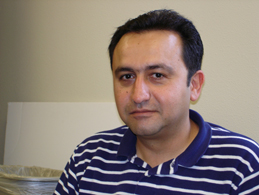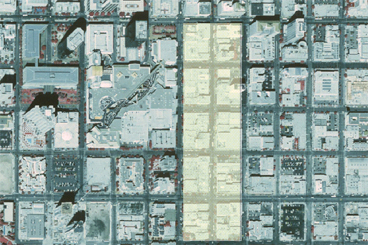Babak Jafarian: Enabling Mobile Internet Access for Security and Popular Applications
10.29.04 -- "I believe in pushing the IP infrastructure to the very last base station and managing mobile user access to the Internet through a seamless IP network," says Babak Jafarian.
|
He was hired a bit over a year ago by the UCSD Division of Calit² as a part-time senior development engineer to oversee mobile and cell wireless network design and deployment. His first project was to design and demonstrate a wireless "security perimeter" around the Coronado Bridge last year.
More recently, Jafarian has been devoting his time to the RESCUE project, in particular instrumenting a 2 x 5 block area of San Diego's downtown Gaslamp District with wireless base stations and cameras to provide wireless, ubiquitous, broadband access to serve public safety and provide the "free amenity" of Internet access in the area.
"We chose downtown San Diego for this testbed," says Jafarian, "because it's a bit more 'real-world' than the UCSD campus. Propagation of the wireless signals here is different, and there's more concentrated foot and auto traffic that can be monitored with respect to public safety."
The project will provide a network to support rapid tactical deployment for emergency responders and, on a more ongoing basis, enable wireless IP video for security monitoring of special events that attract large numbers of people.
|
It will also benefit downtown more generally: free Internet access will be good for the businesses in the area, and it can even be used for real-time traffic reports. Other applications are likely to emerge once the infrastructure is in place and the public learns about it.
This project teams an unusual assortment of groups that don't typically work with each other: UCSD, the City of San Diego, the San Diego Police Department, and industrial partners SENTRE Partners (real estate developer), and SkyRiver Communications and BandwidthNow (both bandwidth providers). The cooperation among all parties has been critical to the quickness in design, development, and installation of the technology.
"It was Calit² that brought these groups together to create the real value of the project," says Jafarian. "SENTRE Partners provided access to building roofs for installation of equipment. Without their help, it would have taken us 6-9 months to work through normal procedures. The City of San Diego and UCSD made cherry pickers available and the Police Department shut down selected streets so we could deploy equipment quickly. Each group understands the benefits of this project based on their own needs."
The infrastructure consists of three zones with overlapping systems. Jafarian and his team are integrating 5.2-GHz transmitters on lampposts, as the backhaul mechanism, with wireless mesh networks. This hybrid solution creates continuous coverage over the 10-block area.
"If one of the nodes goes down," says Jafarian, "we can cope because of redundancy. We see this infrastructure as a prototype for future wireless deployments."
Jafarian is in discussions with several UCSD professors about other solutions. "We want to experiment with other technologies in the Gaslamp," he says, "such as Truong Nguyen's peer-to-peer video and voice streaming platform that runs on an iPAQ. We'd like to use point-to-point connections to see how it really works."
What especially appeals to Jafarian and others working on this project is that it's practical. "This is less research than design and deployment," he says.
And students love it because they get the opportunity to test equipment, protocols, and algorithms, not to mention actually put a real network together. Often they come from the famed UCSD projects course, ECE 191, which has produced some astounding talent and impressive Calit² prototypes.
"Students need this kind of technical, hands-on experience to complement a lot of the theoretical training they get in the classroom," says Jafarian. "It makes them much more employable in industry."
Installation of the Gaslamp testbed should be completed by the end of the year.



